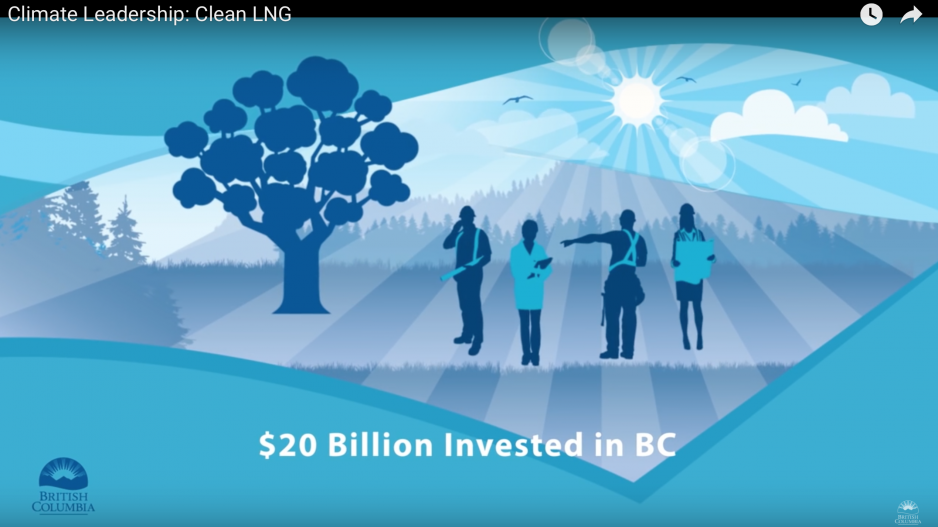The BC Liberal government launched four animated ads promoting its much-criticized Climate Leadership Plan two days after the party’s annual convention earlier this month.
Advanced Education Ministry spokesman Rodney Porter refused to release the budget for the campaign, telling BIV instead to wait until the annual July release of public accounts.
Contractors include TV, print and out-of-home media buyer Vizeum, online media buyer Kimbo and producer St. Bernadine Mission. Kimbo is owned by Kim Pickett, a longtime supporter of Premier Christy Clark who designed both the party’s 2013 logo and Clark’s 2011 leadership campaign logo.
“The lengths that the premier and government will go to use taxpayers' money for electioneering,” said NDP critic Carole James. “The non-action plan. They’re advertising when they didn’t do anything, [the Premier] didn’t accept it.”
Clark released the Climate Leadership Plan on a Friday in mid-August, long after the Clark-appointed Climate Leadership Team’s November report said the government would fail to meet its greenhouse gas emission targets by 2020. Committee member Tzeporah Berman was among many environmentalists who slammed the plan on Twitter. “This is not a climate plan. It's not even policy. It’s just PR,” she wrote.
One of the ads trumpets “clean and affordable electricity” to come from the $9 billion Site C dam after it’s built. But the 2014 Joint Review Panel Report listed numerous adverse impacts to wildlife and farmland that would be caused by flooding the valley. BC Hydro recently admitted that the project would take until 2094 to pay off. The government has refused to show whether the $1.75 billion Peace River Partners construction bid was the lowest and it has also kept secret the names of those who were entrusted to evaluate the bids.
Another spot, on the theme of so-called clean tech, shows images of windmills and solar panels and claims B.C. has more than 68,000 green jobs.
B.C. is supposed to have its fifth wind farm this fall but, earlier this year, the Canadian Wind Energy Association closed its B.C. office, because BC Hydro shifted its focus to the Site C megaproject.
“While B.C. has tremendous untapped potential for wind energy … it’s also true that, at this time, there’s no vision of short-term opportunities emerging in B.C.” CanWEA president Robert Hornung told BIV at the time.
As for the employment figures, they come from a 2015 report by consultant Delphi which counted 12,246 public mass transit and rail workers, 8,821 hydropower workers and 2,827 federal, provincial and local government employees among B.C.’s green jobs.
Another spot heralds the $20 billion that the government claims has been invested already on LNG. Porter said that figure is “based on details released periodically, by industry, when updates about LNG-related projects are announced.”
BIV asked for a detailed list of the $20 billion allegedly invested, but Porter only sent links to news releases about the $2 billion-a-year that Progress Energy Canada said in 2015 that it was spending on natural gas exploration in North Montney and $60 million in local contract spending since 2014 for Fortis BC’s Tilbury LNG expansion.
Citing Canadian Association of Petroleum Producers research, Porter said $4.9 billion was invested in B.C. in 2015 for exploration and production. “Based on internal evaluations of industry activity, the Government of British Columbia estimates up to 60% of this capital is linked to LNG-related planning,” he wrote.
During the 2013 election, Clark had forecast three LNG plants operating in B.C. by 2020. Prospects have dimmed amid a global gas glut and development of plants in U.S., Australia and Russia.
The ad campaign began four days after Woodfibre LNG said it could begin construction on B.C.’s first LNG export plant in 2017. On the same day, BC Hydro announced subsidies for LNG plants that use electricity.
Notably absent from the Nov. 4 Clark photo op at the site of the former pulp mill was Squamish Nation Chief Ian Campbell, who told the Squamish Chief that the band’s 25 conditions for approval have not all been met. “Our Woodfibre LNG work simply isn't finished, it's too early to celebrate,” he said.
The $36 billion Petronas LNG proposal near Prince Rupert received federal environmental approval earlier this fall, but awaits a final investment decision. LNG minister Rich Coleman recently admitted the Malaysian state-owned corporation and its partners are re-evaluating the project because of higher construction prices.
In July, regulators in Hawaii shot down the takeover of the island state’s utility by Florida’s NextEra, which scuttled Fortis B.C.’s 20-year LNG export deal.




